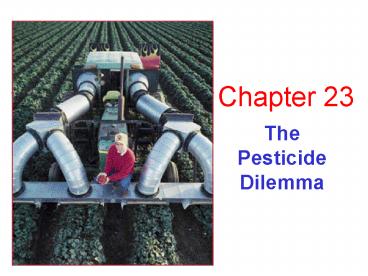The Pesticide Dilemma PowerPoint PPT Presentation
1 / 27
Title: The Pesticide Dilemma
1
The Pesticide Dilemma
Chapter 23
2
What is a Pesticide?
- First-Generation Pesticides
- Inorganic compounds (e.g., lead, mercury)
- Botanicals (e.g., nicotine, pyrethrin)
3
What is a Pesticide?
- Second-Generation Pesticides
- Synthetic botanicals (e.g., pyrethroids)
- DDT
4
What is a Pesticide?
- The Major Groups of Insecticides
- Chlorinated hydrocarbon (e.g., DDT)
- Organophosphates (e.g., malathion)
- Carbamates (e.g., carbaryl)
5
What is a Pesticide?
- The Major Kinds of Herbicides
- Selective herbicides
- (e.g., 2,4-D kills broad-leaved plants)
- Nonselective herbicides
- (e.g., glyphosate, aka Round-UpTM)
6
Benefits and Problems with Pesticides
- Benefit Disease Control
7
Benefits and Problems with Pesticides
- Benefit Crop production
- Farmers save 3 - 5 in crops for every 1
invested into pesticides
8
Benefits and Problems with Pesticides
- Problem Evolution of Genetic Resistance
9
Benefits and Problems with Pesticides
- Problem Evolution of Genetic Resistance
- Creates a pesticide treadmill
Pesticide application
10
Benefits and Problems with Pesticides
- Problem Evolution of Genetic Resistance
- Resistance Management
- Create a refuge (no pesticide applied)
- Avoid repeated use of same pesticide
11
Benefits and Problems with Pesticides
- Problem Imbalances in the Ecosystem
12
Benefits and Problems with Pesticides
- Problem Imbalances in the Ecosystem
- Creation of New Pests
13
Benefits and Problems with Pesticides
- Problem Persistence, Bioaccumulation, and
Biological Magnification
14
Benefits and Problems with Pesticides
- Problem Mobility in the Environment
15
Risks of Pesticides to Human Health
- Short-term Effects of Pesticides
- Handling of food with pesticide residue
16
Risks of Pesticides to Human Health
- Short-term Effects of Pesticides
- Case-in-Point The Bhopal Disaster
- 40 tons of methyl isocyanate gas released
- 600,000 people exposed
- 2,500 immediately killed
- 2,500 more killed through time
- 50,000-60,000 have serious health problems
17
Risks of Pesticides to Human Health
- Long-term Effects of Pesticides
- Potentially higher risk of cancer
- Sterility
- Miscarriage / birth defects
- Potentially higher risk for Parkinsons disease
18
Alternatives to Pesticides
- Using Cultivation Methods to Control Pests
- Interplant mixtures of plants
- Strip cutting
- Planting, fertilizing, and irrigating at proper
time - Crop rotation
19
Alternatives to Pesticides
- Biological Controls
- Using naturally occurring diseases, parasites,
or predators to control a pest - Pheromones and Hormones
- Use pheromones to attract insects to traps
- Synthetic hormones induce abnormal development
- Reproductive Controls
- Sterile-male technique inundate pest
population with large numbers of sterile males
20
Alternatives to Pesticides
- Genetic Controls
- Using Genetically Modified plants (GMOs)
- Case-in-Point Bt, Its Potential and Problems
- Genetically modified corn to produce Bt toxin
- Potential problem may affect non-target
species, such as monarch butterfly - Quarantine
21
Alternatives to Pesticides
- Integrated Pest Management
22
Alternatives to Pesticides
- Integrated Pest Management
Rice Production in Indonesia
23
Alternatives to Pesticides
- Irradiating Foods
- Predominantly used on meats
- Kills many microorganisms
24
Laws Controlling Pesticide Use
- Food, Drug, and Cosmetics Act (1938)
- Pesticide Chemicals Amendment (1954)
- Delaney Cause (1958)
- Federal Insecticide, Fungicide, and Rodenticide
Act (1947)
25
Laws Controlling Pesticide Use
- Food, Drug, and Cosmetics Act (1938)
- Pesticide Chemicals Amendment (1954)
- Delaney Cause (1958)
- Federal Insecticide, Fungicide, and Rodenticide
Act (1947) - Food Quality Protection Act (1996)
26
The Manufacture and Use of Banned Pesticides
- Some US companies still make banned or seriously
restricted pesticides and export the product. - This can potentially lead to the importation of
food tainted with banned pesticides
27
The Manufacture and Use of Banned Pesticides
- The Global Ban of Persistent Organic Pollutants

